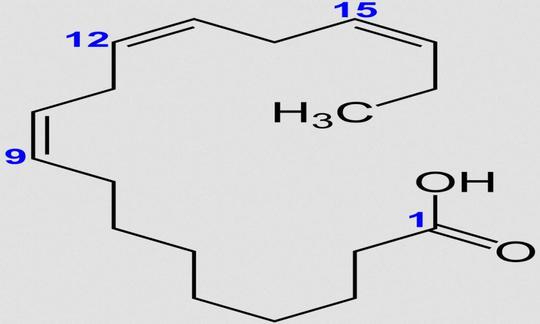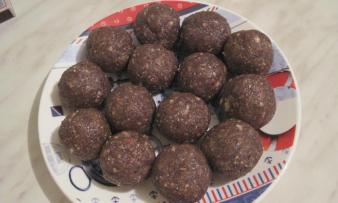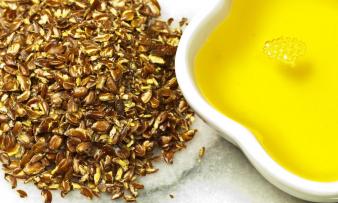Alpha-Linolenic acid; ALA; 18:3 omega-3
Conclusion:
As a result of using more cooking oil, vegans and vegetarians often consume an excess of omega-6 fatty acids, and their ratio of omega-6 to omega-3 fatty acids is then even worse than in the case of omnivores. This can be fatal.
Our motto is to “eat natural whole foods.”
Erb Muesli has been developed to compensate for this poor ratio. It contains much larger amounts of “anti-inflammatory omega-3” than of omega-6, which promotes inflammation.
Vegans who are pregnant or breast-feeding should pay special attention to achieving a healthy ratio to ensure that they are producing enough DHA.
Alpha-linolenic acid (ALA) is an essential n-3 polyunsaturated fatty acid that is one of the omega-3 fatty acids.
Essential means that our body cannot produce (synthesize) this fatty acid on its own, and we therefore need to get it from our diet.
Our body, for example, needs alpha-linolenic acid to produce the omega-3 fatty acids eicosapentaenoic acid (EPA) and docosahexaenoic acid (DHA). Both of these substances have anti-inflammatory effects.
See article A Vegan Diet Can Be Unhealthy. Nutrition Mistakes.
Sources:
The primary sources of α-linolenic acids are nuts and seeds such as flaxseed (20 g/100 g), chia seeds (18), walnuts (9), and the corresponding oils: flaxseed oil (53) and walnut oil (15). In addition, canola oil (9) and green herbs and vegetables such as avocados (0.1) and dried oregano (0.6) include significant amounts. Plants contain almost exclusively α-linolenic acid, whereas docosahexaenoic acid (DHA) and eicosapentaenoic acid (EPA) are primarily found in fish such as eel, carp, and sardines as well as in algae.1
Losses during storage and preparation:
Linolenic acid is very sensitive to oxidation. Oils with a high alpha-linolenic acid content such as flaxseed oil should therefore be stored in a dark bottle away from light, not heated, and used within a short period of time. In order to optimally take advantage of the nutrients in flaxseed and other oilseeds, you should use flaxseed directly after freshly grinding. After the seeds are ground, they are also very sensitive to oxidation, and it is best not to store them but instead to eat them immediately.
See Erb Muesli, a recipe designed to compensate for our daily deficiencies by providing more ALA (omega-3 fatty acids) than LA. A serving of this muesli alone covers the daily requirement of ALA.
Nutrition / Health:
From alpha-linolenic acid, the body forms for instance the omega-3 fatty acids eicosapentaenoic acid (EPA) and docosahexaenoic acid (DHA). Both have an anti-inflammatory effect!
Daily requirement for long-term health:
For adults, 0.5 % of their daily energy intake should come from α-linolenic acid; this is about 1.5 g.
Since α-linolenic acid is extremely important for brain development, infants and small children need to have a higher total intake of polyunsaturated fatty acids. If the mother consumes adequate levels of both essential fatty acids, then the babyʼs needs are normally covered via breast milk. A healthy intake of omega-3 fatty acids is linked to a ratio of omega-6 fatty acids to omega-3 fatty acids of a maximum of 5:1 instead of 10:1 (or more), which is typical of a normal western diet.2, 3, 4 A ratio of 2:1, such as used to be the case in Japan, is optimal — according to other experts (e.g., Dr. Greger), 1:1 would be even better. 6
Deficiency symptoms and causes:
A low intake of omega-3 fatty acids is associated with an increased risk of cardiovascular diseases; inflammation-associated diseases such as rheumatism; and neurological disorders such as schizophrenia, Alzheimerʼs, depression, and attention deficit hyperactivity disorder (ADHD). Risk factors for poor absorption and limited metabolism also include inactivity, smoking, high alcohol consumption, diabetes, and chronic inflammatory bowel diseases.3, 4, 5
Oversupply:
If you are eating a balanced diet, it is virtually impossible to have an oversupply of omega-3 fatty acids. Studies show that an oversupply of omega-3 fatty acids as a result of taking supplements can cause bleeding and increased LDL cholesterol levels and have a negative effect on the immune system and the function of the white blood cells.
Functions in our body etc:
As with other polyunsaturated fatty acids, alpha-linolenic acid is an essential component of the cell membranes in the human body. They are found in especially high concentrations in the brain and nerve cells and as a component of the retina they are essential for healthy eyes. In addition, polyunsaturated fatty acids are important for the healthy development of the brain and eyes in babies and small children.
Alpha-linolenic acid also plays a key role in inflammatory processes. Most important here is the conversion into the long-chain omega-3 fatty acids eicosapentaenoic acid (EPA) and docosahexaenoic acid (DHA).
This process involves the same enzymes that use linoleic acid (LA, omega-6-fatty acid) to produce dihomo-γ-linolenic acid (DGLA) and arachidonic acid (AA). While the body uses EPA and DGLA to produce the anti-inflammatory eicosanoids (immunomodulators), it uses arachidonic acid to produce eicosanoids that promote inflammation.
The two are therefore in constant competition. If an enzyme is busy converting omega-6 fatty acids into these type of eicosanoids, it cannot assimilate omega-3 fatty acids at the same time. This is why the ratio of the two fatty acids ALA and LA is so essential.
In contrast to LA, ALA has a high affinity to these enzymes. In this way, a sufficient intake of foods rich in alpha-linolenic leads to both an increase in EPA synthesis and a decrease in the synthesis of arachidonic acid. To maintain the activity of the enzymes, it is also necessary to have a sufficient supply of magnesium, calcium, vitamin B6, biotin, and zinc.2,3,4,5
In addition, ALA widens the blood vessels, helping to prevent atherosclerosis and thromboses. DHA and EPA are also thought to help prevent osteoporosis, Parkinsonʼs, autoimmune diseases, and rheumatic disorders. They inhibit the emergence of type 2 diabetes, obesity, and kidney diseases.
Absorption and metabolism:
As part of the fat metabolism process, alpha-linolenic acid is broken down by mechanical and enzymatic action in the gastrointestinal tract (mouth, stomach, and small intestine). After the fatty acids are broken down, they reach the intestinal cells via the micelles and from there bound as lipoproteins continue via the blood and lymph to the liver and other target cells such as brain, heart, and skin cells.2
Storage, consumption, and losses:
The acyl-coenzyme A binding protein serves as an intracellular pool and carrier of activated long-chain fatty acids and ensures the resynthesis of triglycerides and phospholipids in the smooth endoplasmic reticulum. The degradation of fatty acids takes place in all of our body cells and is localized in the mitochondria (beta-oxidation).
Structure:
Alpha-linolenic acid is an n-3 unsaturated fatty acid with 18 carbon atoms.
Literature / Sources:
- The USDA, US nutritional database.
- Biesalski, Hans Konrad and Grimm, Peter: Taschenatlas der Ernährung (Pocket atlas of nutrition); Sixth edition (2015); Georg Thieme Verlag, Stuttgart and New York.
- Zimmermann, Michael, Schurgast, Hugo, and Burgerstein Uli P.: Burgersteins Handbuch Nährstoffe (Bugersteinʼs handbook of nutrients), Ninth edition (2000); Karl F. Haug Verlag, Heidelberg.
- Pietrzik K, Golly I, and Loew D: Handbuch Vitamine. Für Prophylaxe, Beratung und Therapie (Handbook of vitamins. For prophylaxis, consultancy, and therapy). Urban & Fischer Verlag, Munich 2008.
- Claus Letzmann, Markus Keller: Vegetarische Ernährung: 3.Auflage (2013); Eugen Ulmer Verlag, Stuttgart
- Michael Greger, MD (Dr. med.): How Not to Die; Macmillan (2015)
Stuffed Eggplant with Nut and Pomegranate Filling is a delicious and hearty Iranian dish.
Zucchini Spaghetti with Hemp Pesto and Almond Parmesan is a delicious raw dish that is easy to prepare and a nice alternative to pasta.
Our date and walnut balls with carob powder are naturally sweet, very quick to prepare, and a nice healthy snack.
Cold-pressed linseed oil (linseed oil, flax oil) is rich in health-promoting omega-3 fatty acids. Tip: Use fresh and store in the refrigerator. Organic?
Linseed (golden linseed, flax) has the highest concentration of the polyunsaturated omega-3 fatty acid alpha-linolenic acid (ALA) at 23 g/100 g.
Hemp oil has different colors depending on how it is produced and has a nutty taste. It contains a high proportion of unsaturated fatty acids, including gamma-l









Comments